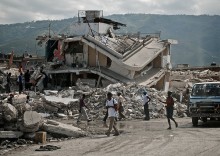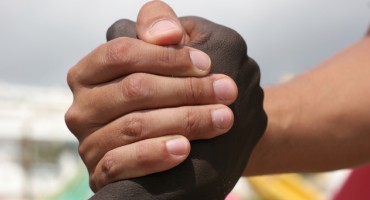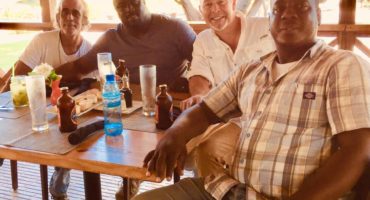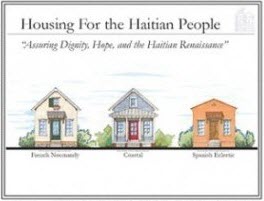Five Cities for Haiti
In the immediate aftermath of Haiti’s devastating 2010 earthquake, Jim Lange founded Haiti Recovery & Development Company, LLC (HR&DC) with the mission to provide “Dignity for the Dead, Hope and Opportunity for the Living.” In Jim’s view, this has been and will always be, the guiding mantra for HR&DC activities and is the unyielding standard against which all of the company’s efforts will be judged.
While the transformation of the mass and unmarked graves into the Haitian National Memorial and Peace Park is the company’s primary objective and will fulfill the “Dignity for the Dead” portion of the mantra, the “Hope and Opportunity for the Living” portion of the broader HR&DC mission will be achieved through the creation and implementation of a comprehensive recovery and development program. It is HR&DC’s vision that this will be Haiti’s version of the Marshall Plan. Here is how HR&DC’s founder Jim Lange summarizes the company’s complex mission:
“…Through HR&DC it is my intention to catalyze the creation of a responsible and sustainable economic engine whereby Haiti and its people achieve both self-reliance and enhanced sovereignty. Through strategic alliance partnerships with charitable and for-profit organizations, leading governments, academia, international institutions and agencies, the Government of Haiti and the citizens of Haiti, our team will push forward on efforts to (a) catalyze the growth of a new sense of Haitian nationalism, (b) educate and train the Haitian citizenry, and (c) teach the values and scope of a free market economy. Ultimately, we will combine the strengths of many to achieve real and lasting prosperity.
HR&DC’s master plan for achieving the stated goals, is to help establish the footprint for five modern communities, strategically located throughout Haiti. Our program, known as the “5 Cities For Haiti” initiative, is designed to methodically groom multiple disparate, yet synergistic, cities into existence. Doing so will help counteract the disabling trend whereby the capital of Haiti, Port au Prince, has systematically reduced the actual Country of Haiti to secondary status. Haiti is a country, not a city and here is where failed policies must be amended. – HR&DC CEO Jim Lange”
History

Haiti’s Capital, Port-au-Prince is on the Gulf of Gonâve and has been the country’s largest city since it was first incorporated under the colonial rule of the French, in 1749. The French laid out the city in a grid pattern and called it L’Hôpital.
Port au Prince has suffered frequently in its history, including fires, civil strife, and earthquakes. Much of the city was destroyed by quakes in 1751 and 1770, foreshadowing future disasters.
Over the years, significant political influence, from both internal and external forces, conspired to funnel all political and economic interests into the small footprint of Port au Prince. This concentration of interests has created a myriad of problems for the country resulting in*:
- Ranking 149 out of 182 on the United Nations Human Development Index
- Having a life expectancy of 55 years for women and 53 years for men
- Ranking as the third hungriest country in the world after Somalia & Afghanistan
- Scoring an Adult literacy of about 62%
- One of the poorest countries in the world
- The poorest country in the western hemisphere
- 78% of Haitians live on less than $2 US per day
- The richest 1% of the population controls nearly half of all of Haiti’s wealth
While the noted rankings are certainty troubling, the “concentration of interests” strategy also ignored one inconvenient and tragic truth: The Enriquillo-Plantain Garden fault system runs straight through Port Au Prince. The city’s recorded history of devastating earthquakes was to be repeated.
January 12, 2010: A 7.0 earthquake effectively leveled Port-au-Prince
The quake destroyed the now much larger city, just as has happened in the past. Haiti’s prized Cathedrale de Port-au-prince, the capital building, the Presidential Palace, many of the ministerial buildings and most of the central historic area of the city was destroyed. The resulting displacement of Haitians left with nowhere to live was unfathomable:**
- At the peak of displacement, around 2.3 million people, including 302,000 children, were left out of their homes.
- The Government of Haiti estimated that 105,000 houses were completely destroyed and 188,383 houses collapsed or were badly damaged across all affected areas.
- The Haitian Ministry of Education estimates that 4,992 schools were affected by the earthquake – 23 percent of all schools in Haiti. Of these, 3,978—80 percent of the affected schools—were either damaged or destroyed and were therefore closed after the quake.
Given this catastrophic destruction and massive need for housing, schools, enterprise and jobs, coupled with the inescapable looming of Enriquillo-Plantain Garden fault system and additional potential plate shifting and resulting earthquakes in Port au Prince, it is the conclusion and vision of The Haiti Recovery & Development Company that our Five Cities for Haiti initiative is fundamentally necessary for Haiti's recovery and its future self reliance.
Images from the Field
Five New Haitian Cities Initiative
Dignity for the Dead, Hope and Opportunity for the Living
Project Goal and Objectives
Goal:
To help establish the footprint of five modern cities strategically located throughout Haiti to create an economic engine for Haitian self-reliance.
In HR&DC's vision, each community will have:
- a stand-alone water treatment facility that would serve the needs of the new community and its surrounding communes
- a reliable power supply
- agricultural development to sustain local life and to generate income
- a formal business district with a Chamber of Commerce
- an enterprise zone where manufacturing suitable for the local population would take place
- a trade school.
Within these sectors, housing will also be incorporated to begin meeting the dire shortage of available, affordable and humane living accommodations.
To ensure that all will benefit from the overall initiative, HR&DC has crafted a development model encompassing everything from medieval agricultural vocations to doctorate-level, white-collar professions and every stratum in between. If Haiti is to join the modern world, it must do so “collectively,” and our aim is to include one and all in every aspect of the recovery and development process.
Project Current Status
HR&DC’s “5 Cities For Haiti” initiative is actively underway in 3 separate locations and under review in 2 additional locations:
- Croix des Bouquets; Transitioning resettlement camps into a city
- Mole Saint-Nicolas
- Tapio & Titanyen
- Two communities in the South are presently being reviewed
Project Next Steps
Each community initiative is at its own unique stage of development. For additional information, please see the project overview for the individual city you’re most interested in or contact HR&DC for further updates.
Recent Blog Posts
VIEW ALL - 15 January 2019 by Bob Linger, in Blog,Haitian National Memorial & Peace Park,HR&DC,Jim's Corner,Jim's Corner
15 January 2019 by Bob Linger, in Blog,Haitian National Memorial & Peace Park,HR&DC,Jim's Corner,Jim's CornerDignity, Healing is a Two Way Street. Jim Lange HRDC
Haiti Trip (January ‘19); Day Five: I have arrived at the Port au Prince airport...READ MORE + 14 January 2019 by Jim Lange, in Blog,Economic Development,Education,Jim's Corner,Jim's Corner,Job Creation
14 January 2019 by Jim Lange, in Blog,Economic Development,Education,Jim's Corner,Jim's Corner,Job CreationJim Lange works on Job Creation, Religion and Higher Education in Haiti
Haiti Trip (January ‘19); Day Four: Today, I turn my full attention to the livin...READ MORE + 13 January 2019 by Bob Linger, in 2010 Earthquake,Blog,HR&DC,Jim's Corner,Jim's Corner
13 January 2019 by Bob Linger, in 2010 Earthquake,Blog,HR&DC,Jim's Corner,Jim's CornerSunday in Haiti. Friendship, Simple Meal. Healing.
Haiti Trip (January ‘19); Day Three: It’s a beautiful Sunday in Haiti. The sun i...READ MORE +





